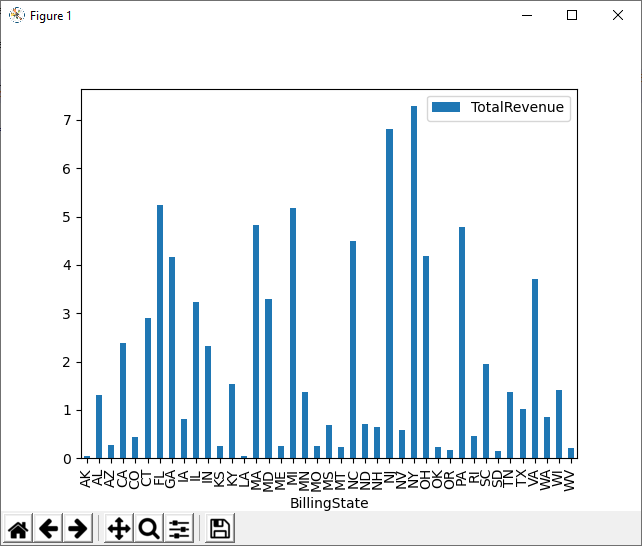Discover how a bimodal integration strategy can address the major data management challenges facing your organization today.
Get the Report →Use pandas to Visualize Paylocity Data in Python
The CData Python Connector for Paylocity enables you use pandas and other modules to analyze and visualize live Paylocity data in Python.
The rich ecosystem of Python modules lets you get to work quickly and integrate your systems more effectively. With the CData Python Connector for Paylocity, the pandas & Matplotlib modules, and the SQLAlchemy toolkit, you can build Paylocity-connected Python applications and scripts for visualizing Paylocity data. This article shows how to use the pandas, SQLAlchemy, and Matplotlib built-in functions to connect to Paylocity data, execute queries, and visualize the results.
With built-in optimized data processing, the CData Python Connector offers unmatched performance for interacting with live Paylocity data in Python. When you issue complex SQL queries from Paylocity, the driver pushes supported SQL operations, like filters and aggregations, directly to Paylocity and utilizes the embedded SQL engine to process unsupported operations client-side (often SQL functions and JOIN operations).
Connecting to Paylocity Data
Connecting to Paylocity data looks just like connecting to any relational data source. Create a connection string using the required connection properties. For this article, you will pass the connection string as a parameter to the create_engine function.
Set the following to establish a connection to Paylocity:
- RSAPublicKey: Set this to the RSA Key associated with your Paylocity, if the RSA Encryption is enabled in the Paylocity account.
This property is required for executing Insert and Update statements, and it is not required if the feature is disabled.
- UseSandbox: Set to true if you are using sandbox account.
- CustomFieldsCategory: Set this to the Customfields category. This is required when IncludeCustomFields is set to true. The default value for this property is PayrollAndHR.
- Key: The AES symmetric key(base 64 encoded) encrypted with the Paylocity Public Key. It is the key used to encrypt the content.
Paylocity will decrypt the AES key using RSA decryption.
It is an optional property if the IV value not provided, The driver will generate a key internally. - IV: The AES IV (base 64 encoded) used when encrypting the content. It is an optional property if the Key value not provided, The driver will generate an IV internally.
Connect Using OAuth Authentication
You must use OAuth to authenticate with Paylocity. OAuth requires the authenticating user to interact with Paylocity using the browser. For more information, refer to the OAuth section in the Help documentation.
The Pay Entry API
The Pay Entry API is completely separate from the rest of the Paylocity API. It uses a separate Client ID and Secret, and must be explicitly requested from Paylocity for access to be granted for an account. The Pay Entry API allows you to automatically submit payroll information for individual employees, and little else. Due to the extremely limited nature of what is offered by the Pay Entry API, we have elected not to give it a separate schema, but it may be enabled via the UsePayEntryAPI connection property.
Please be aware that when setting UsePayEntryAPI to true, you may only use the CreatePayEntryImportBatch & MergePayEntryImportBatchgtable stored procedures, the InputTimeEntry table, and the OAuth stored procedures. Attempts to use other features of the product will result in an error. You must also store your OAuthAccessToken separately, which often means setting a different OAuthSettingsLocation when using this connection property.
Follow the procedure below to install the required modules and start accessing Paylocity through Python objects.
Install Required Modules
Use the pip utility to install the pandas & Matplotlib modules and the SQLAlchemy toolkit:
pip install pandas pip install matplotlib pip install sqlalchemy
Be sure to import the module with the following:
import pandas import matplotlib.pyplot as plt from sqlalchemy import create_engine
Visualize Paylocity Data in Python
You can now connect with a connection string. Use the create_engine function to create an Engine for working with Paylocity data.
engine = create_engine("paylocity:///?OAuthClientID=YourClientId&OAuthClientSecret=YourClientSecret&RSAPublicKey=YourRSAPubKey&Key=YourKey&IV=YourIV&InitiateOAuth=GETANDREFRESH&OAuthSettingsLocation=/PATH/TO/OAuthSettings.txt")
Execute SQL to Paylocity
Use the read_sql function from pandas to execute any SQL statement and store the resultset in a DataFrame.
df = pandas.read_sql("SELECT FirstName, LastName FROM Employee WHERE EmployeeId = '1234'", engine)
Visualize Paylocity Data
With the query results stored in a DataFrame, use the plot function to build a chart to display the Paylocity data. The show method displays the chart in a new window.
df.plot(kind="bar", x="FirstName", y="LastName") plt.show()

Free Trial & More Information
Download a free, 30-day trial of the CData Python Connector for Paylocity to start building Python apps and scripts with connectivity to Paylocity data. Reach out to our Support Team if you have any questions.
Full Source Code
import pandas
import matplotlib.pyplot as plt
from sqlalchemy import create_engin
engine = create_engine("paylocity:///?OAuthClientID=YourClientId&OAuthClientSecret=YourClientSecret&RSAPublicKey=YourRSAPubKey&Key=YourKey&IV=YourIV&InitiateOAuth=GETANDREFRESH&OAuthSettingsLocation=/PATH/TO/OAuthSettings.txt")
df = pandas.read_sql("SELECT FirstName, LastName FROM Employee WHERE EmployeeId = '1234'", engine)
df.plot(kind="bar", x="FirstName", y="LastName")
plt.show()






